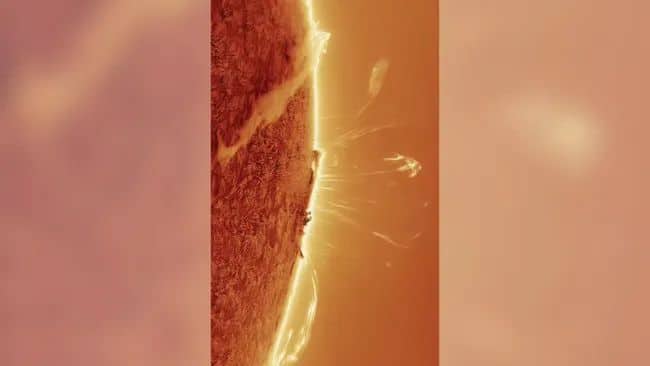Astrophotographer Andrew McCarthy has once again amazed sky watchers with his incredible close-up images of the sunspot region AR3697, which was responsible for the dazzling Northern Lights display last month. McCarthy captured these images right from his backyard, showcasing the spectacular events happening on the surface of the Sun.
Sunspots, like the one McCarthy has been monitoring, are massive, dark regions on the Sun’s surface, cooler than their surroundings due to intense magnetic activity. This magnetic activity can block some of the Sun’s heat, leading to phenomena such as solar flares and coronal mass ejections. When these solar events send electrical charges towards Earth, they interact with atmospheric gases, giving rise to the mesmerizing Northern Lights.
Back in May, a Category 5 solar storm—the strongest possible—sparked an unusually bright display of auroras. McCarthy hasn’t taken his eyes off sunspot region AR3697 since, capturing the dynamic changes and flares as it now turns to face Earth once more.
“Unlike most celestial objects, the Sun looks quite different from day to day, and is filled with exciting events like flares or coronal mass ejections. There’s always something interesting to look at!” McCarthy shared with Space.com. His skill in recording these changes is evident, as he even managed to capture plasma loops that seemed to dance across the Sun’s surface.
His intricate process involves manually aligning each tile of a solar mosaic, removing atmospheric artifacts, and adding color post-processing to enhance the overall image. “This is what it looks like when I manually align each tile of a solar mosaic. I do it manually because I get an intimate look at each panel—so I know if I need to go back and restack it. This is the part of astrophotography that is pretty tedious and turns a lot of people off,” he explained on Twitter.
McCarthy’s dedication and expertise have allowed him to perfect his backyard observatory setup. “My equipment is always ready to go, as I have built an observatory to house my solar telescope and have it ready at the push of a button,” he told Space.com. “Capturing the timelapse footage is simple, but it took a long time to learn how to do it effectively. That’s where my years of experience have helped me!”
On Twitter, he shared a timelapse video showing the sunspot’s plasma ‘flames’ dancing, emphasizing that these ‘flames’ are larger than Earth. This attention to detail and commitment to capturing the Sun’s daily changes keeps McCarthy’s audience captivated and eager for more breathtaking solar imagery.
As Earth rotates and AR3697 faces us again, there’s a good chance the Northern Lights will light up the skies over the next few days. The National Oceanic and Atmospheric Administration provides a helpful 30-90 minute forecast for those eager to witness this celestial event.
Andrew McCarthy’s ability to consistently capture and share these stunning images of the Sun offers a remarkable glimpse into the dynamic and ever-changing nature of our closest star. With the potential for another Northern Lights display on the horizon, sky watchers remain on high alert, ready for the next breathtaking show.

